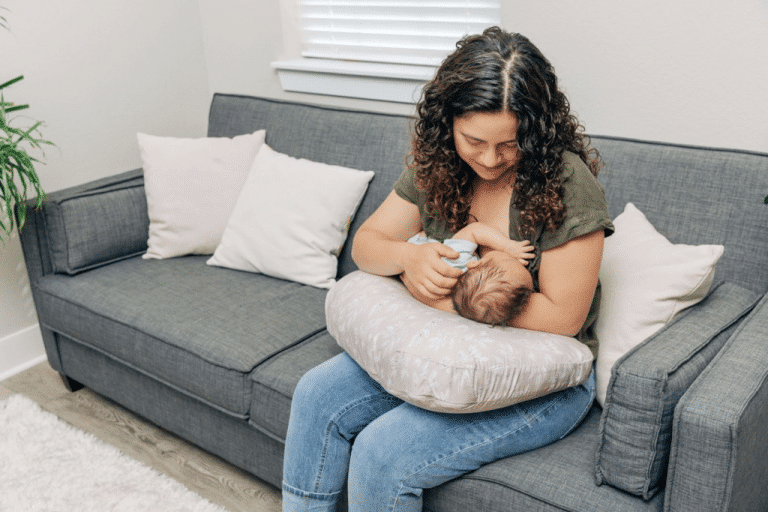Moving your toddler to their own bed can feel overwhelming. Trust me, I know. I’ve been there with my two kids.
But here’s the truth: Both parents and toddlers need good sleep. Parents want their space back.
Kids need room to stretch and learn to sleep on their own. It’s a natural part of growing up.
The best part? Your toddler can gain confidence by having their own space. They learn to feel safe alone.
They get better sleep without adult movement waking them. I can help you make this change work.
From Co-Sleeping to Own Bed: A Simple Guide for Parents
The change from sleeping with parents to sleeping alone needs careful planning.
First, you must pick the right bed based on your child’s age and size.
Then, help your child feel good about this big step. The key is making their room a place they want to be.
Add things they like and make sure they feel safe. Talk to them about the change in simple words they understand.
Stay with them at first, then slowly step back. Most important? Keep doing the same things each night.
Your child learns what to expect when you stay firm with your plan.
1. Choose the Type of Bed According to Their Age
For children under 3 years old, a crib remains the safest choice.
The high sides keep them from falling out during sleep.
Just ensure they haven’t tried climbing out – that’s when safety becomes a worry.
Kids above 3 years can move to a toddler bed or regular bed.
A toddler bed sits lower to the ground and often has small rails.
This makes getting in and out safer. If you pick a regular bed, add a side rail for protection.
Many parents choose a twin or double bed. It gives kids plenty of space to move around and works for years to come.
2. Prepare Your Toddler
Start talking about the new bed two weeks before making the switch. Keep your tone happy and bright.
Say things like, “You’re getting so big now,” and “Look at this comfy new bed just for you!”
Try playing with dolls or stuffed animals, showing them sleeping in their own beds.
Read books about kids sleeping in big-kid beds.
Ask older siblings or cousins to share their good experiences.
Let your child visit their new room often during the day.
Make it fun – play games there, read stories, or build forts.
This helps them see their room as a good place to be.
3. Make a Comfortable Environment for Your Toddler
Set the right temperature in their room – not too hot, not too cold. Add a small light that stays on all night to help them see if they wake up.
Pick sheets and blankets that feel soft and cozy. Put their favorite toys near the bed.
Add pictures they like on the walls. Keep their pajamas and comfort items in easy reach.
Make sure the room isn’t too bright or too dark. Store books on low shelves where they can reach them.
Keep the floor clear of toys at bedtime to prevent trips. Put a small rug beside the bed for warm feet in the morning.
4. Communicate
Tell your child what’s happening in simple words: “Tonight you’ll sleep in your big bed.”
Keep your voice calm and happy. Show them you’re excited about this change.
Answer their questions simply. If they seem worried, say, “I’m right down the hall” or “Your teddy will stay with you all night.”
Please don’t make it sound like a big deal. Treat it like a normal part of growing up.
Remind them often that you’re proud of them.
Say things like, “You’re doing so well in your new bed” or “I knew you could do this!” This builds their confidence.
5. Spend a Few Nights in Their Room
Start by sitting next to their bed until they fall asleep. You can hold their hand or pat their back gently.
Each night, move your chair a bit further from the bed, first to the middle of the room, then near the door.
Tell them exactly where you’ll be: “Mommy will sit in this chair while you fall asleep.”
Keep things quiet and calm. Don’t talk much – this is sleep time, not playtime.
After a few nights of sitting at the door, tell them you’ll check on them every few minutes.
This helps them feel safe while learning to sleep alone.
6. Be Consistent
Keep the same bedtime every night. Follow your routine exactly – bath, teeth brushing, story, then bed.
When your child gets up, calmly walk them back to bed without talking much.
Don’t give in to “one more story” or “five more minutes.” This only teaches them that asking works.
If they cry, wait a few minutes before checking. Keep these checks short and boring.
Never go back to letting them sleep in your bed – this confuses them about the rules.
Even on hard nights, stick to your plan. Your firm approach helps them learn faster.
What is the Right Time to Sleep Train Your Toddler in Their Bed?
Pick a time when life is calm – no big changes like a new baby or starting school.
Your child should be healthy, not teething or fighting a cold.
Look for signs they’re ready: following simple directions, understanding basic explanations, and showing interest in doing things “like a big kid.”
Choose a two-week period when you can stay home and keep regular schedules.
Start when your child isn’t overtired from skipped naps or late nights.
The best time? When you feel ready to stick with the plan, even through tough nights.
Conclusion
Look, moving your toddler to their own bed takes work, but you have all the tools you need right here.
Pick the right bed, make their room cozy, talk to them about it, and stick to your plan.
Will there be tough nights? Yes. Will your child test your limits? Of course. But stay strong; each small step leads to success.
Remember why you started: everyone needs good sleep to be their best.
Your toddler is learning a skill they’ll use forever. Keep this guide handy. Follow these steps.
And know that soon enough, your toddler will sleep soundly in their own space.










